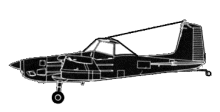
ASN Wikibase Occurrence # 291902
This information is added by users of ASN. Neither ASN nor the Flight Safety Foundation are responsible for the completeness or correctness of this information.
If you feel this information is incomplete or incorrect, you can submit corrected information.
| Date: | Friday 18 August 2006 |
| Time: | 15:45 LT |
| Type: |  Cessna A188B |
| Owner/operator: | Rolla Flying Service, Inc. |
| Registration: | N9224R |
| MSN: | 18802167T |
| Year of manufacture: | 1975 |
| Total airframe hrs: | 8167 hours |
| Engine model: | Teledyne Continental IO-550-D |
| Fatalities: | Fatalities: 0 / Occupants: 1 |
| Aircraft damage: | Substantial |
| Category: | Accident |
| Location: | Rolla, North Dakota -
 United States of America United States of America
|
| Phase: | Unknown |
| Nature: | Agricultural |
| Departure airport: | Rolla, ND (06D) |
| (06D) | |
| Investigating agency: | NTSB |
| Confidence Rating: |
The aerial-application flight experienced a loss of engine power during a low-altitude turn while spraying a field. The pilot performed an immediate forced landing into a nearby wheat field. The airplane was damaged when it encountered the wheat crop, spun around, and impacted terrain. The on-site investigation revealed that the engine crankshaft had fractured and the propeller had separated from the engine. The propeller was never located and is believed to be in a nearby slough or a densely wooded area. The fracture of the crankshaft and the cracking of the oil slinger flange were the result of an extreme load on the front of the engine pushing aft and offset from the crankshaft centerline. Ground impact is the most likely source of the load. The offset load created bending loads on the crankshaft that led to an overstress fracture of the crankshaft. The aft loads pushed the crankshaft aft into the case, causing one side of the oil slinger flange to crack because it was restrained by the case. The location of the crankshaft fracture initiation was not diametrically opposite from the final fracture region, consistent with some amount of clockwise (as viewed from the aft) rotation during the fracture.
Probable Cause: The pilot's failure to maintain clearance from terrain during the aerial-application flight, and the loss of engine power due to the overstress failure of the engine crankshaft sustained during ground impact. Contributing to the accident was the low-altitude at which the flight was being operated and the wheat crop the airplane encountered during the forced landing.
Accident investigation:
 |
|
Sources:
NTSB CHI06LA240
Revision history:
| Date/time | Contributor | Updates |
|---|---|---|
| 08-Oct-2022 06:36 | ASN Update Bot | Added |
Corrections or additions? ... Edit this accident description
The Aviation Safety Network is an exclusive service provided by:


 ©2024 Flight Safety Foundation
©2024 Flight Safety Foundation